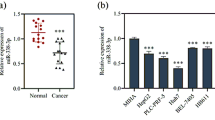Abstract
Objectives
To study the roles of STARD13 in cellular apoptosis of hepatocellular carcinoma (HCC).
Results
Quantitative real-time PCR and immunohistochemistry analyses showed that the expression levels of STARD13 and Fas were lower in clinical HCC tissues than in normal tissues and were positively correlated, which is consistent with the results analyzed by The Cancer Genome Atlas (TCGA) data. Patients with higher STARD13 or Fas expression levels had longer overall survival. Additionally, STARD13 3′-UTR enhanced cellular apoptosis and the 3′-UTRs of STARD13 and Fas were predicted to harbor nine similar miRNA binding sites. And STARD13 3′-UTR promoted Fas expression in a 3′-UTR- and miRNA-dependent way and increased the sensitivity of HCC cells to chemotherapy. Importantly, the coding sequence of STARD13 did not increase Fas expression.
Conclusions
STARD13 3′-UTR promotes HCC apoptosis through acting as a ceRNA for Fas.







Similar content being viewed by others
References
Chang S, He S, Qiu G, Lu J, Wang J, Liu J, Fan L, Zhao W, Che X (2016) MicroRNA-125b promotes invasion and metastasis of gastric cancer by targeting STARD13 and NEU1. Tumour Biol 37:12141–12151
Denzler R, Agarwal V, Stefano J, Bartel DP, Stoffel M (2014) Assessing the ceRNA hypothesis with quantitative measurements of miRNA and target abundance. Mol Cell 54:766–776
Ferroudj S, Yildiz G, Bouras M, Iscan E, Ekin U, Ozturk M (2016) Role of fanconi anemia/BRCA pathway genes in hepatocellular carcinoma chemoresistance. Hepatol Res. doi:10.1111/hepr.12675
Hu X, Yang X, He Q, Chen Q, Yu L (2014) Glyoxalase 1 is up-regulated in hepatocellular carcinoma and is essential for HCC cell proliferation. Biotechnol Lett 36:257–263
Karreth FA, Reschke M, Ruocco A, Ng C, Chapuy B, Leopold V, Sjoberg M, Keane TM, Verma A, Ala U et al (2015) The BRAF pseudogene functions as a competitive endogenous RNA and induces lymphoma in vivo. Cell 161:319–332
Kumar MS, Armenteros-Monterroso E, East P, Chakravorty P, Matthews N, Winslow MM, Downward J (2014) HMGA2 functions as a competing endogenous RNA to promote lung cancer progression. Nature 505:212–217
Li X, Zheng L, Zhang F, Hu J, Chou J, Liu Y, Xing Y, Xi T (2016) STARD13-correlated ceRNA network inhibits EMT and metastasis of breast cancer. Oncotarget 7:23197–23211
Nasrallah A, Saykali B, Al Dimassi S, Khoury N, Hanna S, El-Sibai M (2014) Effect of StarD13 on colorectal cancer proliferation, motility and invasion. Oncol Rep 31:505–515
Ray P, Guha D, Chakraborty J, Banerjee S, Adhikary A, Chakraborty S, Das T, Sa G (2016) Crocetin exploits p53-induced death domain (PIDD) and FAS-associated death domain (FADD) proteins to induce apoptosis in colorectal cancer. Sci Rep 6:32979
Salmena L, Poliseno L, Tay Y, Kats L, Pandolfi PP (2011) A ceRNA hypothesis: the Rosetta stone of a hidden RNA language? Cell 146:353–358
Tang F, Zhang R, He Y, Zou M, Guo L, Xi T (2012) MicroRNA-125b induces metastasis by targeting STARD13 in MCF-7 and MDA-MB-231 breast cancer cells. PLoS ONE 7:e35435
Tay Y, Karreth FA, Pandolfi PP (2014) Aberrant ceRNA activity drives lung cancer. Cell Res 24:259–260
Thomson DW, Dinger ME (2016) Endogenous microRNA sponges: evidence and controversy. Nat Rev Genet 17:272–283
Torre LA, Bray F, Siegel RL, Ferlay J, Lortet-Tieulent J, Jemal A (2015) Global cancer statistics, 2012. CA Cancer J Clin 65:87–108
Wang Y, Lin G (2016) TP53INP1 3′-UTR functions as a ceRNA in repressing the metastasis of glioma cells by regulating miRNA activity. Biotechnol Lett 38:1699–1707
Zheng L, Li X, Gu Y, Ma Y, Xi T (2014) Pseudogene CYP4Z2P 3′ UTR promotes angiogenesis in breast cancer. Biochem Biophys Res Commun 453:545–551
Zheng L, Li X, Gu Y, Lv X, Xi T (2015) The 3′UTR of the pseudogene CYP4Z2P promotes tumor angiogenesis in breast cancer by acting as a ceRNA for CYP4Z1. Breast Cancer Res Treat 150:105–118
Zheng L, Li X, Meng X, Chou J, Hu J, Zhang F, Zhang Z, Xing Y, Liu Y, Xi T (2016) Competing endogenous RNA networks of CYP4Z1 and pseudogene CYP4Z2P confer tamoxifen resistance in breast cancer. Mol Cell Endocrinol 427:133–142
Acknowledgements
This work was supported by the Scientific Research Building Projects of the Health Department of Hubei province (No. JX6C-48). And we thanked Prof. Hu for critical reviewing this work.
Author information
Authors and Affiliations
Corresponding author
Ethics declarations
Conflict of interest
The authors declare no conflict of interest.
Rights and permissions
About this article
Cite this article
Zhang, H., Wang, F. & Hu, Y. STARD13 promotes hepatocellular carcinoma apoptosis by acting as a ceRNA for Fas. Biotechnol Lett 39, 207–217 (2017). https://doi.org/10.1007/s10529-016-2253-6
Received:
Accepted:
Published:
Issue Date:
DOI: https://doi.org/10.1007/s10529-016-2253-6




